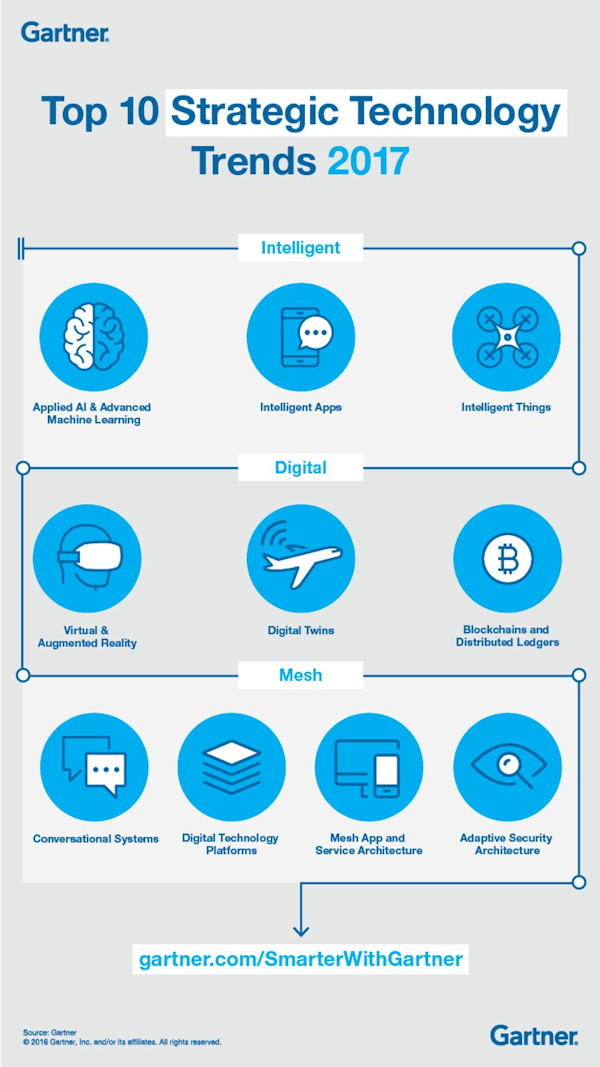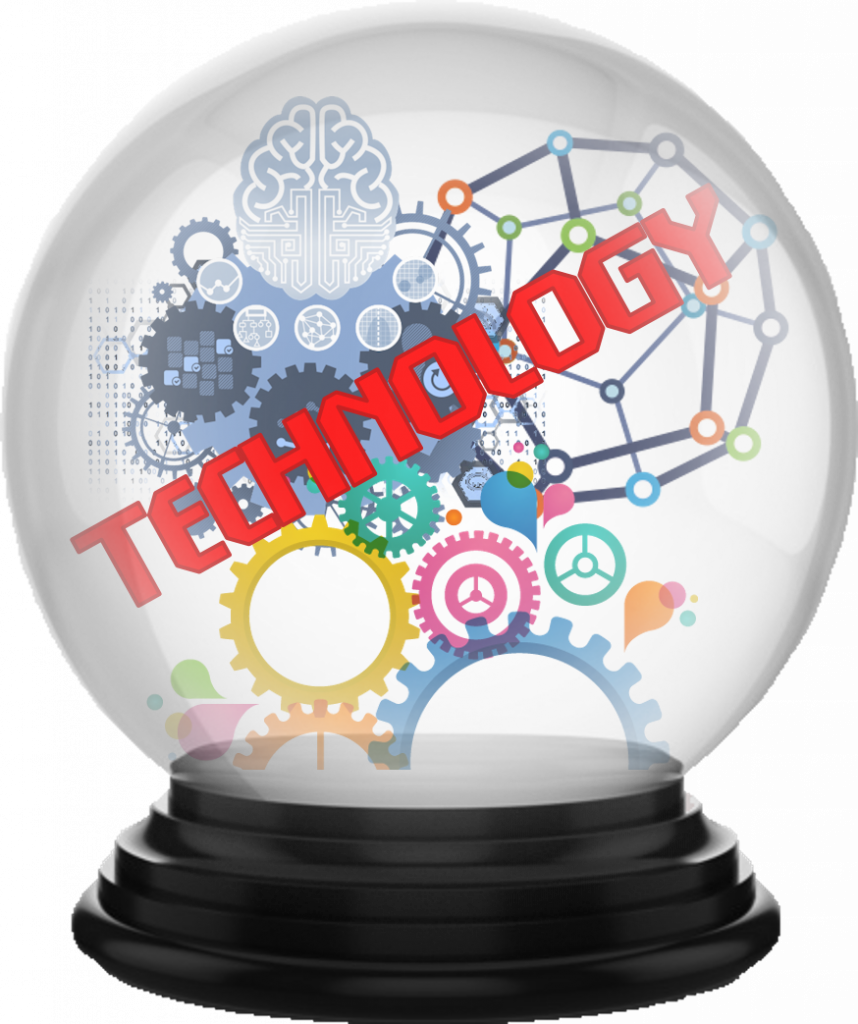‘Tis that time of year when both the brave and the foolish look deeply into their crystal balls and prognosticate about the coming year. Over the coming weeks, I’ll review what some of these intrepid souls are writing about the future. I’ll be looking at both trends and predictions. Trends are important because they reflect things already in play; whereas, predictions often have a more tenuous connection to the present. Of course, trends often lead to predictions. It comes as no surprise, therefore, that some of the first offerings involve trends rather than predictions. Speaking of trends, David Cearley, Vice President at Gartner Research, writes, “Increasingly, the world is becoming an intelligent, digitally enabled mesh of people, things and services.”[1] Then dipping his toe into the waters of prognostication, he predicts, “Technology will be embedded in everything in the digital business of the future, and ordinary people will experience a digitally-enabled world where the lines between what is real and what is digital blur.” To back up his claims, Cearley discusses ten strategic technology trends identified by his colleagues and currently transforming the business landscape (see the attached image).

Intelligent Technology
Cearly notes, “Artificial Intelligence (AI) and machine learning have reached a critical tipping point and will increasingly augment and extend virtually every technology enabled service, thing or application.” He goes on to discuss three intelligent technology trends now in play: artificial intelligence and machine learning; intelligent apps; and intelligent things.
Trend One: AI and Machine Learning. “Creating intelligent systems that learn, adapt and potentially act autonomously rather than simply execute predefined instructions is primarily battleground for technology vendors through at least 2020.” This trend is not new. Last year Frost & Sullivan analysts noted, “We can expect more cognitive computing platforms to bring about a new way of delivering services.”[2]
Trend Two: Intelligent Apps. “Intelligent apps, which include technologies like virtual personal assistants (VPAs), have the potential to transform the workplace by making everyday tasks easier (prioritizing emails) and its users more effective (highlighting important content and interactions). However, intelligent apps are not limited to new digital assistants — every existing software category from security tooling to enterprise applications such as marketing or enterprise resource planning (ERP) will be infused with AI enabled capabilities.”
Trend Three: Intelligent Things. “New intelligent things generally fall into three categories: robots, drones and autonomous vehicles. Each of these areas will evolve to impact a larger segment of the market and support a new phase of digital business but these represent only one facet of intelligent things. Existing things including Internet of Things (IoT) devices will become intelligent things delivering the power of AI enabled systems everywhere including the home, office, factory floor, and medical facility.” The IoT is another trend changing the business landscape forever. Frost & Sullivan analysts note, “We are starting to see sensors being embedded in physical objects ranging from medical devices, wearables, highways, cars, industrial machines to mobile phones and these are then linked to very high speed and powerful networks. … All these examples point to what the future of big data will mean for organizations.”
Digital Technology
Cearley notes, “The lines between the digital and physical world continue to blur creating new opportunities for digital businesses.” Most analysts agree that organizations built around an industrial age model (i.e., siloed departments and divisions) will have to transform into digital enterprises to thrive in the future. Cearley discusses three digital technologies: virtual and augmented reality; digital twins; and blockchains/distributed ledgers.
Trend Four: Virtual & Augmented Reality. “Virtual reality (VR) and augmented reality (AR) transform the way individuals interact with each other and with software systems creating an immersive environment. … Immersive experiences with AR and VR are reaching tipping points in terms of price and capability but will not replace other interface models. Over time AR and VR expand beyond visual immersion to include all human senses. Enterprises should look for targeted applications of VR and AR through 2020.” Predictions about VR/AR taking off have been made in the past only to have sputtered out. The fact that VR/AR technologies are now connected to smartphone technology may make these new predictions come true.
Trend Five: Digital Twins. “Within three to five years, billions of things will be represented by digital twins, a dynamic software model of a physical thing or system. Using physics data on how the components of a thing operate and respond to the environment, as well as data provided by sensors in the physical world, a digital twin can be used to analyze and simulate real world conditions, responds to changes, improve operations and add value.” Digital twin technology should really advance once general quantum computers are developed. The really value of digital twins is in their predictive capabilities (i.e., helping decision making and avoiding tragic mistakes).
Trend Six: Blockchains and Distributed Ledgers. “Blockchain and distributed-ledger concepts are gaining traction because they hold the promise of transforming industry operating models in industries such as music distribution, identify verification and title registry. They promise a model to add trust to untrusted environments and reduce business friction by providing transparent access to the information in the chain.” Although blockchain technology does hold promise, it also has some serious drawbacks. To learn more about the drawbacks, read my article entitled “Blockchain Technology: Silver Bullet or Simply Buzz.”
Mesh Technology
“The mesh,” Cearley writes, “refers to the dynamic connection of people, processes, things and services supporting intelligent digital ecosystems. As the mesh evolves, the user experience fundamentally changes and the supporting technology and security architectures and platforms must change as well.” As noted above, the IoT is part of the mesh. Cearley discusses four mesh technology trends: conversational systems; digital technology platforms; mess app and service architecture; and adaptive security architecture.
Trend Seven: Conversational Systems. “Conversational systems can range from simple informal, bidirectional text or voice conversations such as an answer to ‘What time is it?’ to more complex interactions such as collecting oral testimony from crime witnesses to generate a sketch of a suspect. Conversational systems shift from a model where people adapt to computers to one where the computer ‘hears’ and adapts to a person’s desired outcome.” Frost & Sullivan analysts noted, “The battleground for Intelligent Personal assistants will increase with nearly every large technology company investing in developing an intelligent personal assistant platform. … These platforms will offer a wide range of services which include booking a taxi, ordering food, groceries and other online goods.”
Trend Eight: Digital Technology Platforms. “Digital technology platforms are the building blocks for a digital business and are necessary to break into digital. Every organization will have some mix of five digital technology platforms: Information systems, customer experience, analytics and intelligence, the IoT and business ecosystems.” Cognitive computing platforms hold the greatest promise as an all-in-one platform that can integrate both structured and unstructured data and provide decision makers with the actionable insights they need to run a digital enterprise.
Trend Nine: Mesh App and Service Architecture. “The intelligent digital mesh will require changes to the architecture, technology and tools used to develop solutions. The mesh app and service architecture (MASA) is a multichannel solution architecture that leverages cloud and serverless computing, containers and microservices as well as APIs and events to deliver modular, flexible and dynamic solutions. Solutions ultimately support multiple users in multiple roles using multiple devices and communicating over multiple networks.”
Trend Ten: Adaptive Security Architecture. “The evolution of the intelligent digital mesh and digital technology platforms and application architectures means that security has to become fluid and adaptive. Security in the IoT environment is particularly challenging.” In fact, security is one of the greatest challenges facing businesses in the future; hence, all the interest in blockchain technology. But blockchain technology is not sufficient. Some kind of attribute-based access control along with other cyber-security measures are also necessary to confront security challenges. Frost & Sullivan analysts noted, “As platforms become more open due to the rapid adoption of Cloud, Mobility and the Internet of Things, security threats will rise and this will become the single biggest issue to tackle in the ICT industry.”
Summary
Each of these trends deserves a lot more discussion. Taking in total, however, they present a compelling picture of the digital future. These trends will mature at differing rates; but, forward-thinking companies won’t wait to strategize how they could affect their business.
Footnotes
[1] David Cearley, “Gartner’s Top 10 Strategic Technology Trends For 2017,” Forbes, 26 October 2016.
[2] Cindy Lin, “Five Big Technology Predictions into 2016: Frost & Sullivan,” SMAhome, 26 November 2015.





